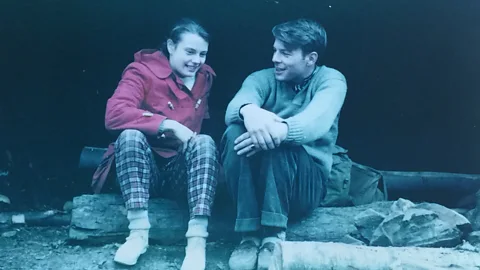'It's a brave new life': How an intrepid New Jersey couple survived the Alaskan wilderness on a homestead
 Skye Skinner
Skye SkinnerIn this BBC archive clip from 1962, Alan Whicker meets the adventurous New Jersey couple who chose to tough it out in the Alaskan wilderness in a new life as homesteaders. In History finds out what happened next.
On 20 May 1862, US President Abraham Lincoln signed into law the Homestead Act, legislation that would kickstart the greatest land giveaway in American history.
One hundred years later, the BBC's intrepid Alan Whicker tracked down a young couple in the Alaskan wilderness who represented the same naive optimism and pioneer spirit that led thousands before them to go west and carve out new lives for themselves.
After meeting the remarkable Su Lum in 1962, Whicker observed: "It's a brave new life for young wives who are ready to butcher and preserve half a moose; for the vigorous and the determined."
Su and her husband Burt, a secretary and schoolteacher, had married a year earlier and drove north from Boonton, New Jersey to build a new life in Alaska. To find the couple, Whicker and his television crew had to take a plane journey followed by another hour's drive "along a do-it-yourself road". Sleeping in hammocks and with not much shelter, it was clear the Lums had chosen a difficult path for themselves. And Su was due to have a baby in 10 days' time.
If they could last the distance, after three years the US government would grant them 160 acres of land. While it may have been free, the price had to be paid in sweat and toil. They had to clear and cultivate at least 20 of those acres and build a habitable home, all while surviving three freezing Alaskan winters.
This was the way that much of the US was created, thanks to the 1862 Act – trees had to be felled and cleared, ground flattened, and log cabins built. In all, 10% of the United States, 270 million acres, was claimed under the Act, with prime land being snapped up quickly.
Homesteading fell sharply out of favour after the 1930s but the law remained in effect until 1976. In the less hospitable terrain of Alaska, provisions for homesteading continued right up until 1986. It really was the last American frontier.
For New Jersey schoolmaster Burt Lum, their Alaskan adventure was a chance to carve out some personal space.
"We're both basically wilderness-minded people," he said. "We like the out-of-doors ever so much and want to get away from crowds. As a matter of fact, we intend to do as primitively as we can, living here and taking our game from the woods and our fish from the streams. There are dozens of varieties of wild berries here, and, of course, we will eventually have gardens. But these are things that have long appealed to us as a change from this hurried modern life."
When President Lincoln signed the Act, the Civil War was still raging, and Alaska was still part of Russia. It wasn't until 1867 that the United States bought the territory for $7.2m. For less than two cents an acre, it gained almost 600,000 sq miles.
In History
In History is a series which uses the BBC's unique audio and video archive to explore historical events that still resonate today. window._taboola = window._taboola || []; _taboola.push({ mode: 'alternating-thumbnails-a', container: 'taboola-below-article', placement: 'Below Article', target_type: 'mix' });
